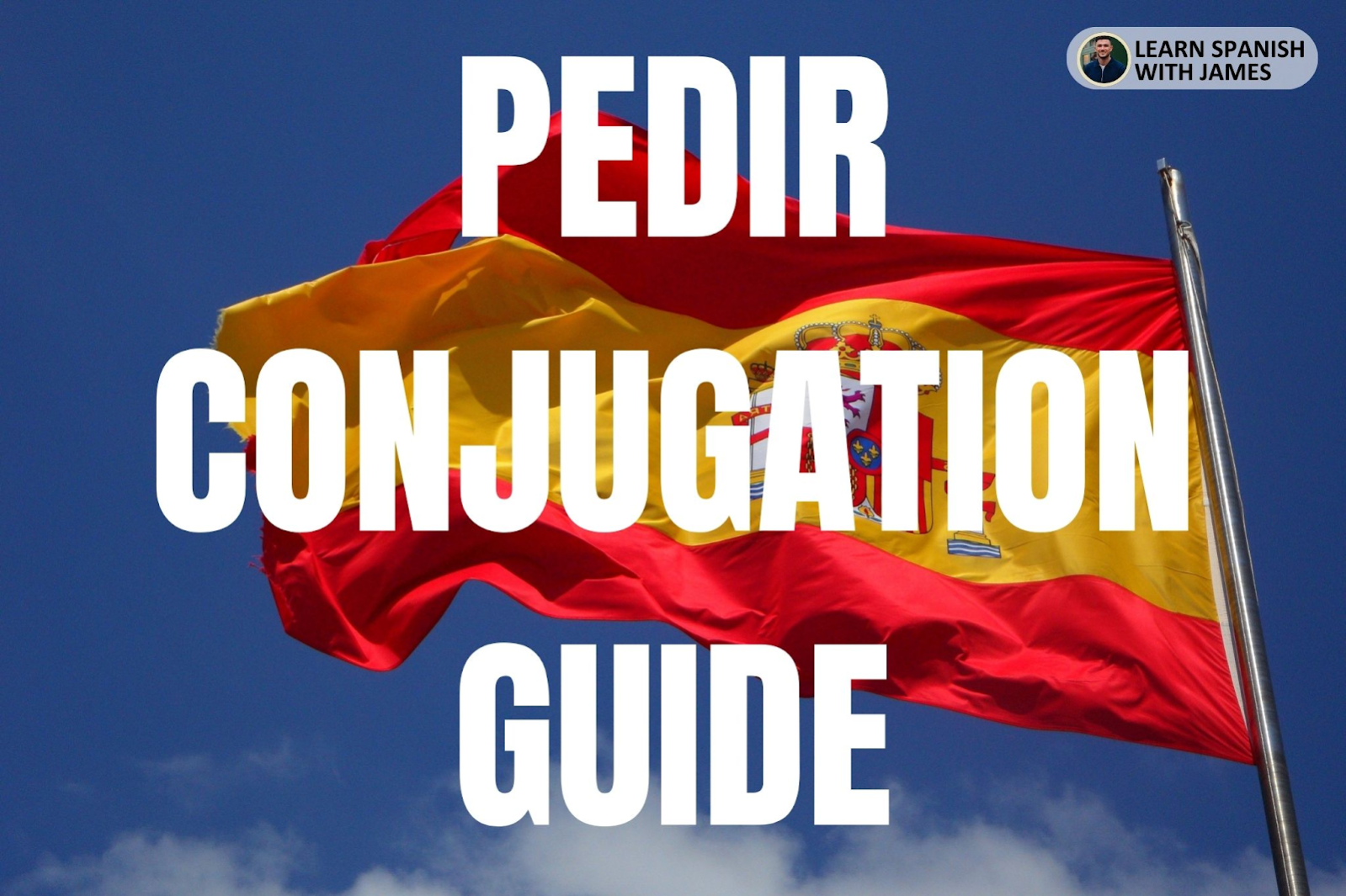Pedir Conjugation Chart & Full Tense Guide

The Spanish verb “pedir” means “to ask for” or “to request.” Like “ir,” it’s an irregular verb, making its conjugation essential knowledge for Spanish learners.
I’m James, from Learn Spanish With James, and host of the Learn Spanish With James Podcast. In this ”pedir” conjugation guide, you’ll find everything you need to learn how to conjugate “pedir” in every Spanish tense.
You will also find verb charts, “pedir” conjugation tables, and example sentences.
Join me as we explore its nuances and usage in everyday phrases, such as “pedir perdón”, “pedir un taxi” or “pedir prestado,” and learn how to use this Spanish verb conjugation just like a native speaker.
Present Tense
Pronouns Pronombres Conjugation
I yo pido
you tú pides
he,she,it, you(formal) él,ella,usted pide
we nosotros,nosotras pedimos
you pl. vosotros, vosotras pedís
they, you pl. (formal) ellos,ellas,ustedes piden
When We Use the Present Tense
The present tense in Spanish is used to describe actions that are currently happening, habitual actions, general truths, or future actions scheduled on a timetable.
In the present tense, “pedir” is used to express current requests or needs. It means “I ask” or “I request”.
The verb ”pedir” can also be used with modal verbs, such as ”poder”.
For example, “Un hombre no puede pedir nada más hermoso que eso” (A man can not ask for anything more beautiful.)
Or, ”Ella no puede pedir mucho más que eso.” or “Todo el lujo que usted puede pedir por un precio agradable.” (All the luxury you can ask for a nice price.)
Below, you will see how to use this irregular verb in the present tense.
Examples of the Verb “Pedir” in the Present Tense
- Yo pido la cuenta por favor. (I ask for the bill, please.)
- Tú pides un café. (You ask for a coffee.)
- Él/Ella pide ayuda. (He/She asks for help.)
- Nosotros pedimos el menú del día. (We ask for the daily menu.)
- Vosotros pedís más información. (You ask for more information.)
- Ellos/Ellas piden disculpas. (They apologize.)
Preterite Tense
Pronouns Pronombres Conjugation
I yo pedí
you tú pediste
he, she. it, you (formal) él, ella, usted pidió
we nosotros, nosotras pedimos
you (plural) vosotros, vosotras pedisteis
they, you (pl. formal) ellos, ellas, ustedes pidieron
When We Use the the Preterite Tense
The preterite tense of “pedir” is used to describe actions that were completed in the past at a specific point in time.
Try not to confuse this with the imperfect tense, which I’ll show you shortly.
In the verb chart above, you will see how to conjugate “pedir” in the preterite tense. I’ve also provided example sentences below.
Examples of the Verb “Pedir” in the Preterite Tense
- Yo pedí un favor ayer. (I asked for a favor yesterday.)
- Tú pediste un aumento de sueldo. (You asked for a raise.)
- Él/Ella pidió prestado mi libro. (He/She borrowed my book.)
- Nosotros pedimos la comida para llevar. (We ordered takeout.)
- Vosotros pedisteis un taxi. (You ordered a taxi.)
- Ellos/Ellas pidieron información adicional. (They asked for additional information.)
Imperfect Tense
Pronouns Pronombres Conjugation
I yo pedía
you tú pedías
he, she, it, you (formal) él, ella, usted pedía
we nosotros, nosotras pedíamos
you (plural) vosotros, vosotras pedíais
they, you(pl. formal) ellos, ellas, ustedes pedían
When We Use the Imperfect Tense
The imperfect tense is used to describe past actions that were ongoing, habitual, or continuous in the past.
For example, “I was asking” or “I was requesting“. It can also mean “used to“, such as “I used to ask” or “I used to request“.
This past tense has a very predictable conjugation pattern for irregular verbs like ”pedir.”
Examples of the Verb “Pedir” in the Imperfect Tense
- Yo pedía ayuda todos los días. (I used to ask for help every day.)
- Tú pedías permiso para salir. (You used to ask for permission to go out.)
- Él/Ella pedía consejos a su abuelo. (He/She used to ask for advice from his/her grandfather.)
- Nosotros pedíamos comida china los domingos. (We used to order Chinese food on Sundays.)
- Vosotros pedíais direcciones con frecuencia. (You used to ask for directions often.)
- Ellos/Ellas pedían más tiempo para terminar el proyecto. (They used to ask for more time to finish the project.)
Future Tense
Pronouns Pronombres Conjugation
I yo pediré
you tú pedirás
he,she,it, you(formal) él,ella,usted pedirá
we nosotros,nosotras pediremos
you pl. vosotros, vosotras pediréis
they, you pl. (formal) ellos,ellas,ustedes pedirán
When We Use the Future Tense
When we use the future tense of “pedir”, we say that we “will ask” or “will request” something.
Do not confuse the future tense with the conditional tense. I outline the key differences in this guide to Spanish verb tenses.
Below, I show you how each “pedir” conjugation works in context in the future tense.
Examples of “Pedir” in the Future Spanish Verb Conjugation
- Yo pediré ayuda cuando la necesite. (I will ask for help when I need it.)
- Tú pedirás información sobre el curso. (You will ask for information about the course.)
- Él/Ella pedirá un préstamo al banco. (He/She will request a loan from the bank.)
- Nosotros pediremos pizza para la cena. (We will order pizza for dinner.)
- Vosotros pediréis un favor a vuestro vecino. (You will ask a favor from your neighbor.)
- Ellos/Ellas pedirán disculpas por su comportamiento. (They will apologize for their behavior.)
Conditional Tense
Pronouns Pronombres Conjugation
I yo pediría
you tú pedirías
he,she,it, you(formal) él,ella,usted pediría
we nosotros,nosotras pediríamos
you pl. vosotros, vosotras pediríais
they, you pl. (formal) ellos,ellas,ustedes pedirían
When We Use the Conditional Tense
The conditional tense is used to express actions that would happen under certain conditions or to convey politeness.
So, in the conditional tense, “pedir” is used to express requests or actions that would happen under certain conditions.
This is one of the easiest tenses to learn, as all you need to do is add the relevant ending to the infinitive form of the verb.
Top Tip: Try to practice the conditional tense with other -IR verbs, including “seguir“, “vivir“, “salir“, “ir“, “escribir“, and “oír“.
You will notice that the the conditional and future tense structure is the same for each, even as irregular verbs.
Examples of the Conditional “Pedir” Conjugation
- Yo pediría ayuda si la necesitara. (I would ask for help if I needed it.)
- Tú pedirías un favor si estuvieras en mi lugar. (You would ask for a favor if you were in my place.)
- Él/Ella pediría perdón si supiera que estaba equivocado/a. (He/She would apologize if he/she knew he/she was wrong.)
- Nosotros pediríamos más tiempo si fuera posible. (We would ask for more time if it were possible.)
- Vosotros pediríais un descuento si fuera necesario. (You would ask for a discount if necessary.)
- Ellos/Ellas pedirían ayuda a sus amigos en caso de emergencia. (They would ask for help from their friends in case of emergency.)
Perfect Tense
Pronouns Pronombres Auxiliary verb ‘haber’ Past Participle
I yo he pedido
you tú has pedido
he,she,it, you(formal) él,ella,usted ha pedido
we nosotros,nosotras hemos pedido
you pl. vosotros, vosotras habéis pedido
they, you pl. (formal) ellos,ellas,ustedes han pedido
When We Use the Perfect Tense
The perfect tense, known in Spanish as the ‘pretérito perfecto’, allows us to talk about actions that have occurred recently or actions that still have an impact on the present.
So, the perfect tense of “pedir” is used to express requests or actions that have been completed recently or have relevance to the present.
We form this tense by using the Spanish verb “haber” and adding the past participle of “pedir” – this is “pedido”.
You are about to find this verb conjugation usage in the next three tenses too.
Examples of the Pretérite Perfect “Pedir” Conjugation
- Yo he pedido una explicación. (I have asked for an explanation.)
- Tú has pedido disculpas. (You have apologized.)
- Él/Ella ha pedido un favor especial. (He/She has asked for a special favor.)
- Nosotros hemos pedido ayuda a los expertos. (We have asked for help from the experts.)
- Vosotros habéis pedido un deseo. (You have made a wish.)
- Ellos/Ellas han pedido permiso para salir. (They have asked for permission to go out.)
Pluperfect Tense
Pronouns Pronombres Auxiliary verb ‘haber’ Past Participle
I yo había pedido
you tú habías pedido
he,she,it, you(formal) él,ella,usted había pedido
we nosotros,nosotras habíamos pedido
you pl. vosotros, vosotras habíais pedido
they, you pl. (formal) ellos,ellas,ustedes habían pedido
When We Use the Pluperfect Tense
The pluperfect tense is used to express actions that had occurred before another past action.
For example, in English, we would say “I had already decided I wasn’t going by the time he offered me a ticket”.
So, in the pluperfect tense, “pedir” is used to express requests or actions that had already been completed before another past action.
Again, we form this tense with the help of the Spanish verb “haber” and the use of the past participle – “pedido”.
Examples of the Pluperfect “Pedir” Conjugation
- Yo había pedido un préstamo antes de la crisis financiera. (I had requested a loan before the financial crisis.)
- Tú habías pedido una cita con el médico antes de sentirte mal. (You had asked for a doctor’s appointment before feeling unwell.)
- Él/Ella había pedido ayuda a sus amigos antes del accidente. (He/She had asked for help from his/her friends before the accident.)
- Nosotros habíamos pedido más información antes de tomar una decisión. (We had asked for more information before making a decision.)
- Vosotros habíais pedido la comida antes de la llegada de los invitados. (You had ordered the food before the guests arrived.)
- Ellos/Ellas habían pedido disculpas sinceramente. (They had apologized sincerely.)
Future Perfect Tense
Pronouns Pronombres Auxiliary verb ‘haber’ Past Participle
I yo habré pedido
you tú habrás pedido
he,she,it, you(formal) él,ella,usted habrá pedido
we nosotros,nosotras habremos pedido
you pl. vosotros, vosotras habréis pedido
they, you pl. (formal) ellos,ellas,ustedes habrán pedido
When We Use the Future Perfect Tense
The future perfect tense is used to express actions that will have been completed by a certain point in the future.
In Spanish, we use this tense to express requests or actions that will have been completed by a certain point in the future.
Again, you will see that “haber” and the past participle are needed. I have written these conjugations below.
Examples of the Future Perfect “Pedir” Conjugation
- Yo habré pedido ayuda antes de que llegues. (I will have asked for help before you arrive.)
- Tú habrás pedido más información para entonces. (You will have asked for more information by then.)
- Él/Ella habrá pedido permiso para salir de vacaciones. (He/She will have asked for permission to go on vacation.)
- Nosotros habremos pedido la cena cuando lleguen nuestros invitados. (We will have ordered dinner by the time our guests arrive.)
- Vosotros habréis pedido un taxi para ir al aeropuerto. (You will have ordered a taxi to go to the airport.)
- Ellos/Ellas habrán pedido disculpas antes de que sea demasiado tarde. (They will have apologized before it’s too late.)
Conditional Perfect Tense
Pronouns Pronombres Auxiliary verb ‘haber’ Past Participle
I yo habría pedido
you tú habrías pedido
he,she,it, you(formal) él,ella,usted habría pedido
we nosotros,nosotras habríamos pedido
you pl. vosotros, vosotras habríais pedido
they, you pl. (formal) ellos,ellas,ustedes habrían pedido
When We Use the Conditional Perfect Tense
The conditional perfect tense enables us to express actions that would have been completed under certain conditions in the past.
Again, we need the Spanish verb ”haber” as an auxiliary verb and the past participle ”pedido.”
Examples of the Conditional Perfect “Pedir” Conjugation
- Yo habría pedido ayuda si hubiera sabido que estabas enfermo/a. (I would have asked for help if I had known you were sick.)
- Tú habrías pedido más tiempo si hubieras tenido la oportunidad. (You would have asked for more time if you had had the chance.)
- Él/Ella habría pedido perdón si se hubiera dado cuenta de su error. (He/She would have apologized if he/she had realized his/her mistake.)
- Nosotros habríamos pedido un préstamo si hubiéramos estado en apuros financieros. (We would have asked for a loan if we had been in financial trouble.)
- Vosotros habríais pedido ayuda a las niñas si hubieseis estado en peligro. (You would have asked for help from the girls if you had been in danger.)
- Ellos/Ellas habrían pedido más información si hubieran tenido dudas. (They would have asked for more information if they had had doubts.)
Present Subjunctive
Pronouns Pronombres Conjugation
I yo pida
you tú pidas
he,she,it, you(formal) él,ella,usted pida
we nosotros,nosotras pidamos
you pl. vosotros, vosotras pidáis
they, you pl. (formal) ellos,ellas,ustedes pidan
When We Use the Present Subjunctive
Next, we have the present subjunctive, which is used to express desires, doubts, recommendations, or hypothetical situations.
We use this tense in subordinate clauses to express requests, desires, or suggestions, and can often do so with nouns.
The Spanish subjunctive is a complex grammatical topic and I won’t delve into here. However, you can see each of the relevant conjugations below.
Examples of the Present Subjunctive “Pedir” Conjugation
- Es importante que yo pida ayuda. (It’s important that I ask for help.)
- No creo que tú pidas demasiado. (I don’t think you ask for too much.)
- Quiero que él/ella pida disculpas. (I want him/her to apologize.)
- Esperamos que nosotros pidamos perdón a tiempo. (We hope we apologize in time.)
- Es necesario que vosotros pidáis permiso. (It’s necessary that you ask for permission.)
- Dudo que ellos/ellas pidan ayuda cuando lo necesiten. (I doubt they ask for help when they need it.)
Imperfect Subjunctive
Pronouns Pronombres Conjugation
I yo pidiera, pidiese
you tú pidieras, pidieses
he,she,it, you(formal) él,ella,usted pidiera, pidiese
we nosotros,nosotras pidiéramos, pidiésemos
you pl. vosotros, vosotras pidierais, pidieseis
they, you pl. (formal) ellos,ellas,ustedes pidieran, pidiesen
When We Use the Imperfect Subjunctive
The imperfect subjunctive Spanish verb conjugation is used to express hypothetical situations, desires, or doubts in the past.
In the imperfect subjunctive, “pedir” is used in subordinate clauses to express hypothetical requests, desires, or suggestions in the past.
Examples of the Imperfect Subjunctive “Pedir” Conjugation
- Ojalá que yo pidiera ayuda antes. (I wish I had asked for help earlier.)
- Preferiría que tú pidieras ayuda a un profesional. (I would prefer you to ask for help from a professional.)
- Dudábamos que él/ella pidiera perdón sinceramente. (We doubted he/she would apologize sincerely.)
- Era importante que nosotros pidieramos más información. (It was important that we asked for more information.)
- Recomendábamos que vosotros pidierais consejo a un experto. (We recommended that you ask for advice from an expert.)
- Era poco probable que ellos/ellas pidieran ayuda sin motivo. (It was unlikely that they would ask for help without reason.)
Affirmative Imperative
Pronouns Pronombres Conjugation
you tú ¡pide!
he,she,it, you(formal) él,ella,usted ¡pida!
we nosotros,nosotras ¡pidamos!
you pl. vosotros, vosotras ¡pedid!
they, you pl. (formal) ellos,ellas,ustedes ¡pidan!
When We Use The Affirmative Imperative
The affirmative imperative, also known as the command form, is used to give direct orders or instructions.
When using the affirmative imperative with the verb “pedir,” we are instructing someone to make a request or ask for something.
Here are examples of how to conjugate ”pedir” in the imperative form.
Examples of “Pedir” in the Affirmative Imperative
- ¡Pide un deseo antes de soplar las velas! (Make a wish before blowing out the candles!)
- ¡Pida disculpas ahora mismo! (Apologize right away!)
- ¡Pidamos ayuda para levantar esta mesa! (Let’s ask for help to lift this table!)
- ¡Pedid permiso antes de entrar! (Ask for permission before entering!)
- ¡Pidan más información si lo necesitan! (Ask for more information if you need it!)
- ¡Pida un taxi para ir al aeropuerto! (Order a taxi to go to the airport!)
Negative Imperative
Pronouns Pronombres Conjugation
you tú ¡no pidas!
he,she,it, you(formal) él,ella,usted ¡no pida!
we nosotros,nosotras ¡no pidamos!
you pl. vosotros, vosotras ¡no pidáis!
they, you pl. (formal) ellos,ellas,ustedes ¡no pidan!
When We Use The Negative Imperative
The negative imperative is used to give commands in the negative form, indicating what should not be done. When using the negative imperative verb conjugation for “pedir,” we are instructing someone not to make a request or ask for something.
Below you will find examples of how to conjugate ”pedir” in the negative imperative form.
Examples of “Pedir” in the Negative Imperative
- ¡No pidas más de lo necesario! (Don’t ask for more than necessary!)
- ¡No pida ayuda si no la necesita! (Don’t ask for help if you don’t need it!)
- ¡No pidamos favores a personas desconocidas! (Let’s not ask for favors from strangers!)
- ¡No pidáis comida si no tenéis hambre! (Don’t ask for food if you’re not hungry!)
- ¡No pidan disculpas sin pensar! (Don’t apologize without thinking!)
- ¡No pida prestado si no puede devolverlo! (Don’t borrow if you can’t return it!)
Online Spanish Courses & Grammar Courses
For a full list of Beginner, Intermediate and Advanced Courses, check out this full list of online Spanish courses.
I put this list together myself, and it comprises a mixture of courses that offer Spanish grammar practice for all levels, Spanish conjugation guides, conversational practice, listening and writing exercises in Spanish, free Spanish courses, and a whole lot more.
The fastest way to learn Spanish is to test a mixture of Spanish resources and choose the course that coincides most with your learning style.
In addition to online Spanish courses, on this site you will find a wide range of Spanish podcasts, Spanish apps, Spanish YouTube channels, and both online and physical Spanish language schools.
Finally, be sure to check out this list of Spanish verb conjugations to perfect your Spanish grammar.

About James – Or Should that be Santiago?
My name is James. I am a Brit with a love for the Spanish language. I have lived in Spain, Argentina, and Costa Rica, and I have been teaching Spanish for over a decade. This site will show you how to master the elements of Spanish grammar that often dishearten learners. I hope you enjoy the site and find it useful.
If you are interested in taking your Spanish to the next level, check out the Courses section for a full list of the Spanish courses I suggest. All reviews are based on my personal opinions.





